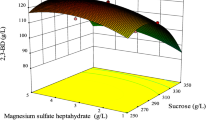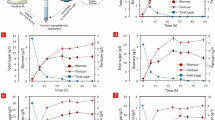Abstract
The effects of culture conditions on 2,3-butanediol (2,3-BD) production and its possible scale-up have been studied. A newly isolated Bacillus amyloliquefaciens B10-127, belonged to GRAS microorganisms and showed a remarkable 2,3-BD producing potency, was used for this experiment. Corn steep liquor, soybean meal and ammonium citrate were found to be the key factors in the fermentation according to the results obtained from the Plackett–Burman experimental design. The optimal concentration range of the three factors was examined by the steepest ascent path, and their optimal concentration were further optimized via response surface methodological approach and determined to be 31.9, 22.0 and 5.58 g/l, respectively. The concentration of the obtained 2,3-BD increased significantly with optimized medium (62.7 g/l) when compared with unoptimized medium (45.7 g/l) and the 2,3-BD productivity was about 2.4-fold (The fermentation time was shorten from 72 to 42 h). To observe scale-up effects, batch fermentation was carried out at various working volumes. At a working volume of 20.0 l, the final 2,3-BD concentration and yield were 61.4 and 0.38 g/g at 36 h with a 2,3-BD productivity of 1.71 g/l h. This result shows similar amount of 2,3-BD obtained in lab-scale fermentation, and it is possible to scale up to larger fermentors without major problems.





Similar content being viewed by others
References
Abdul Rahman MB, Jarmi NI, Chaibakhsh N, Basri M (2011) Modeling and optimization of lipase-catalyzed production of succinic acid ester using central composite design analysis. J Ind Microbiol Biotechnol 38:229–234. doi:10.1007/s10295-010-0817-3
Alam S, Capit F, Weigandg WA, Hong J (1990) Kinetics of 2, 3-butanediol fermentation by Bacillus amyloliquefaciens: effect of initial substrate concentration and aeration. J Chem Technol Biotechnol 41:71–84. doi:10.1002/jctb.280470109
Anvari M, Safari Motlagh MR (2011) Enhancement of 2, 3-butanediol production by Klebsiella oxytoca PTCC 1402. J Biomed Biotechnol 2011:1–7. doi:10.1155/2011/636170
Bas D, BoyacI IH (2007) Modeling and optimization I: usability of response surface methodology. J Food Eng 78:836–845. doi:10.1016/j.jfoodeng.2005.11.024
Bezerra MA, Santelli RE, Oliveira EP, Villar LS, Escaleira LA (2008) Response surface methodology (RSM) as a tool for optimization in analytical chemistry. Talanta 76:965–977. doi:10.1016/j.talanta.2008.05.019
Box GEP, Wilson KB (1951) On the experimental attainment of optimum conditions. J Roy Stat Soc Ser B Method 13:1–45
Box GEP, Hunter JS, Hunter WG (1978) Statistics for experimenters. Wiley, New York, pp 291–334
Celinska E, Grajek W (2009) Biotechnological production of 2, 3-butanediol—current state and prospects. Biotechnol Adv 27:715–725. doi:10.1016/j.biotechadv.2009.05.002
De Mas C, Jansen NB, Tsao GT (1988) Production of optically active 2, 3-butanediol by Bacillus polymyxa. Biotechnol Bioeng 31:366–377. doi:10.1002/bit.260310413
Elibol M (2004) Optimization of medium composition for actinorhodin production by Streptomyces coelicolor A3(2) with response surface methodology. Process Biochem 39:1057–1062. doi:10.1016/s0032-9592(03)00232-2
Garg SK, Jain A (1995) Fermentative production of 2, 3-butanediol: a review. Bioresour Technol 51:103–109. doi:10.1016/0960-8524(94)00136-O
Ghosh S, Swaminathan T (2003) Optimization of process variables for the extractive fermentation of 2, 3-butanediol by Klebsiella oxytoca in aqueous two-phase system using response surface methodology. Chem Biochem Eng Q 17:319–325
Haveren Jv, Scott EL, Sanders J (2008) Bulk chemicals from biomass. Biofuels Bioprod Bioref 2:41–57. doi:10.1002/bbb.43
Hermann BG, Blok K, Patel MK (2007) Producing bio-based bulk chemicals using industrial biotechnology saves energy and combats climate change. Environ Sci Technol 41:7915–7921. doi:10.1021/es062559q
Karin H, Barbel HH (2000) Factors affecting the fermentative lactic acid production from renewable resources. Enzyme Microb Technol 26:87–107. doi:10.1016/S0141-0229(99)00155-6
Kennedy M, Krouse D (1999) Strategies for improving fermentation medium performance: a review. J Ind Microbiol Biotechnol 23:456–475. doi:10.1038/sj.jim.2900755
Ma C, Wang A, Qin J, Li L, Ai X, Jiang T, Tang H, Xu P (2009) Enhanced 2, 3-butanediol production by Klebsiella pneumoniae SDM. Appl Microbiol Biotechnol 82:49–57. doi:10.1007/s00253-008-1732-7
Malinowska E, Krzyczkowski W, Lapienis G, Herold F (2009) Improved simultaneous production of mycelial biomass and polysaccharides by submerged culture of Hericium erinaceum: optimization using a central composite rotatable design (CCRD). J Ind Microbiol Biotechnol 36:1513–1527. doi:10.1007/s10295-009-0640-x
Mu W, Chen C, Li X, Zhang T, Jiang B (2009) Optimization of culture medium for the production of phenyllactic acid by Lactobacillus sp. SK007. Bioresour Technol 100:1366–1370. doi:10.1016/j.biortech.2008.08.010
Neish AC, Blackwood AC et al (1947) Production and properties of 2, 3-butanediol; dissimilation of glucose by Serratia marcescens. Can J Res 25:65–69
Nilegaonkar S, Bhosale SB, Kshirsagar DC, Kapadi AH (1992) Production of 2, 3-butanediol from glucose by Bacillus licheniformis. World J Microbiol Biotechnol 8:378–381. doi:10.1007/BF01198748
Oh IJ, Kim DH, Oh EK, Lee SY, Lee J (2009) Optimization and scale-up of succinic acid production by Mannheimia succiniciproducens LPK7. J Microbiol Biotechnol 19:167–171. doi:10.4014/jmb.0807.447
Parekh M, Formanek J, Blaschek HP (1999) Pilot-scale production of butanol by Clostridium beijerinckii BA101 using a low-cost fermentation medium based on corn steep water. Appl Microbiol Biotechnol 51:152–157. doi:10.1007/s002530051375
Perego P, Converti A, Borghi AD, Canepa P (2000) 2, 3-Butanediol production by Enterobacter aerogenes: selection of the optimal conditions and application to food industry residues. Bioprocess Eng 23:613–620. doi:10.1007/s004490000210
Plackett RL, Burman JP (1946) The design of optimum multifactorial experiments. Biometrika 33:305–325. doi:10.1093/biomet/33.4.305
Rivas B, Moldes AB, Domínguez JM JCP (2004) Development of culture media containing spent yeast cells of Debaryomyces hansenii and corn steep liquor for lactic acid production with Lactobacillus rhamnosus. Int J Food Microbiol 97:93–98. doi:10.1016/j.ijfoodmicro.2004.05.006
Ryad A, Lakhdar K, Majda KS, Samia A, Mark A, Corinne AD, Eric G (2010) Optimization of the culture medium composition to improve the production of hyoscyamine in elicited Datura stramonium L. Hairy roots using the response surface methodology (RSM). Int J Mol Sci 11:4726–4740. doi:10.3390/ijms11114726
Sambrook J, Russell DW (2001) Molecular cloning: a laboratory manual, 3rd edn. Cold Spring Harbor Laboratory, New York
Silveira MM, Wisbeck E, Hoch I, Jonas R (2001) Production of glucose-fructose oxidoreductase and ethanol by Zymomonas mobilis ATCC 29191 in medium containing corn steep liquor as a source of vitamins. Appl Microbiol Biotechnol 55:442–445. doi:10.1007/s002530000569
Syu MJ (2001) Biological production of 2, 3-butanediol. Appl Microbiol Biotechnol 55:10–18
Tran AV, Chambers RP (1987) The dehydration of fermentative 2, 3-butanediol into methyl ethyl ketone. Biotechnol Bioeng 29:343–351. doi:10.1002/bit.260290308
Yang TW, Rao ZM, Zhang X, Lin Q, Xia HF, Xu ZH, Yang ST (2011) Production of 2,3-butanediol from glucose by GRAS microorganism Bacillus amyloliquefaciens. J Basic Microbiol. doi:10.1002/jobm.201100033
Yu EK, Saddler JN (1982) Enhanced production of 2, 3-butanediol by Klebsiella pneumoniae grown on high sugar concentrations in the presence of acetic acid. Appl Environ Microbiol 44:777–784
Yu EK, Saddler JN (1983) Fed-batch approach to production of 2, 3-butanediol by Klebsiella pneumoniae grown on high substrate concentrations. Appl Environ Microbiol 46:630–635
Zeng A, Biebl H, Deckwer W (1990) Effect of pH and acetic acid on growth and 2, 3-butanediol production of Enterobacter aerogenes in continuous culture. Appl Microbiol Biotechnol 33:485–489. doi:10.1007/BF00172538
Zeng AP, Byun TG, Posten C, Deckwer WD (1994) Use of respiratory quotient as a control parameter for optimum oxygen supply and scale-up of 2, 3-butanediol production under microaerobic conditions. Biotechnol Bioeng 44:1107–1114. doi:10.1002/bit.260440912
Zhang L, Sun J, Hao Y, Zhu J, Chu J, Wei D, Shen Y (2010a) Microbial production of 2, 3-butanediol by a surfactant (serrawettin)-deficient mutant of Serratia marcescens H30. J Ind Microbiol Biotechnol 37:857–862. doi:10.1007/s10295-010-0733-6
Zhang L, Yang Y, Sun J, Shen Y, Wei D, Zhu J, Chu J (2010b) Microbial production of 2, 3-butanediol by a mutagenized strain of Serratia marcescens H30. Bioresour Technol 101:1961–1967. doi:10.1016/j.biortech.2009.10.052
Zhang X, Yang T, Lin Q, Xu M, Xia H, Xu Z, Li H, Rao Z (2011) Isolation and identification of an acetoin high production bacterium that can reverse transform 2,3-butanediol to acetoin at the decline phase of fermentation. World J Microbiol Biotechnol. doi:10.1007/s11274-011-0754-y
Acknowledgments
This work was supported by the Program for New Century Excellent Talents in University (NCET-10-0459), the National Natural Science Foundation of China (30970056), the High-tech Research and Development Programs of China (2007AA02Z207), the Fundamental Research Funds for the Central Universities (JUSRP31001), the Program of Introducing Talents of Discipline to Universities (111-2-06) and a Project Funded by the Priority Academic Program Development of Jiangsu Higher Education Institutions.
Author information
Authors and Affiliations
Corresponding author
Rights and permissions
About this article
Cite this article
Yang, T., Zhang, X., Rao, Z. et al. Optimization and scale-up of 2,3-butanediol production by Bacillus amyloliquefaciens B10-127. World J Microbiol Biotechnol 28, 1563–1574 (2012). https://doi.org/10.1007/s11274-011-0960-7
Received:
Accepted:
Published:
Issue Date:
DOI: https://doi.org/10.1007/s11274-011-0960-7




